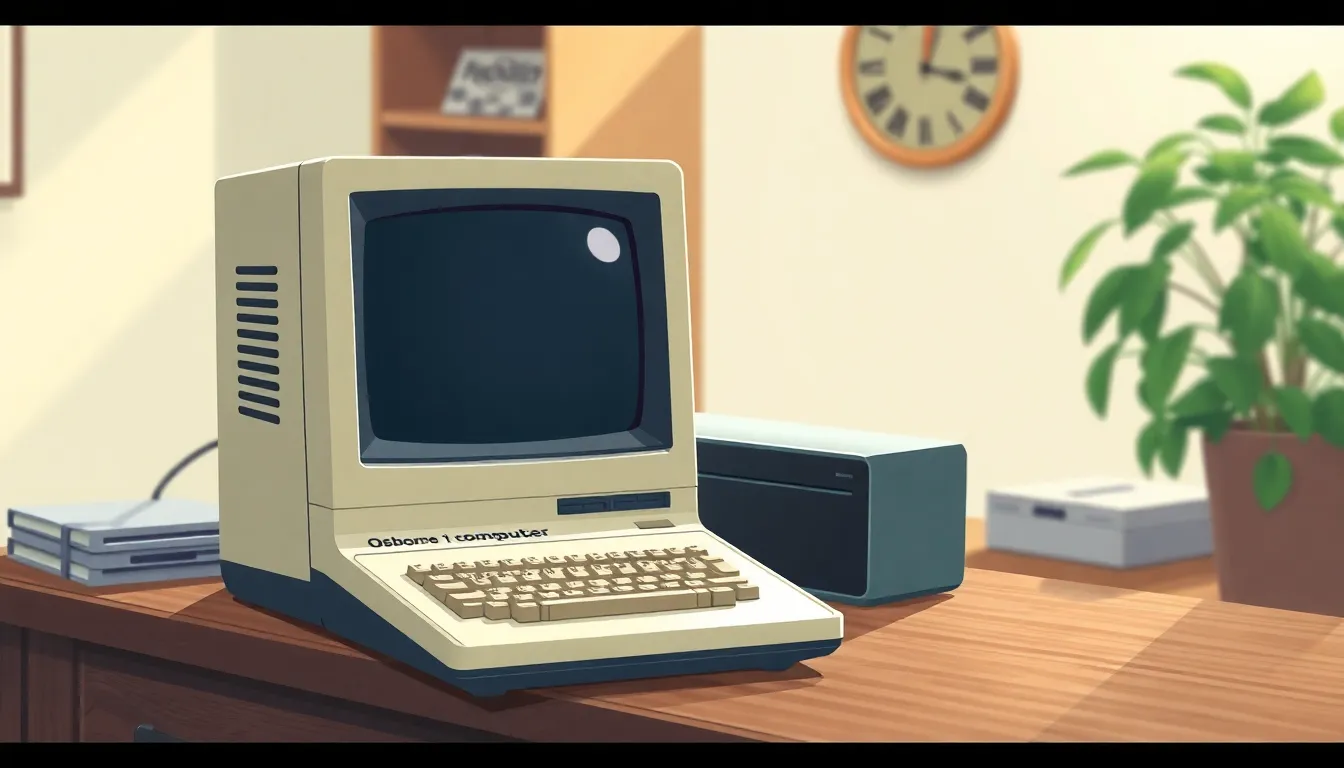Laptops have come a long way since their clunky beginnings, evolving from bulky behemoths to sleek powerhouses that fit snugly in backpacks. Imagine lugging around a device that weighed more than a small dog—thankfully, those days are behind us. Today’s laptops are not just tools; they’re essential companions, enabling everything from binge-watching the latest series to conquering the corporate world.
As technology zooms ahead, it’s fascinating to trace the evolution of these portable wonders. From the first portable computers that made users feel like they were carrying a briefcase full of bricks to the ultra-thin models that can practically fit in your pocket, the journey is nothing short of remarkable. Join in as we dive into the quirky history of laptops, exploring their rise to fame and the innovations that keep them at the forefront of modern life.
Table of Contents
ToggleThe Evolution of Laptops
The evolution of laptops highlights significant advancements in technology. Early models, introduced in the 1980s, weighed over 10 pounds, making portability a challenge. These devices featured small screens and limited processing power, making them impractical for many users.
In the 1990s, manufacturers introduced more efficient components, reducing weight and size. The introduction of the Lithium-ion battery marked a turning point, allowing laptops to operate longer without being plugged in. Innovations in display technology led to the creation of LCD screens, which provided better visuals and reduced bulk.
By the early 2000s, laptops began incorporating faster processors and larger hard drives, expanding functionality. This period saw the advent of wireless technology, enabling users to connect to the internet without cables. Ultrabooks emerged in the 2010s, offering ultra-thin designs without sacrificing performance. Devices like the MacBook Air popularized this trend, showcasing sleek designs and improved battery life.
Presently, laptops prioritize user experience with touchscreen capabilities and 2-in-1 features. Manufacturers use advanced materials, such as magnesium alloys and carbon fiber, to create lightweight yet durable models. The integration of artificial intelligence in laptops enhances functionality, providing users with smart assistance for everyday tasks.
Today, laptops cater to a wide range of users, from casual consumers to professional gamers. Overall, the journey of laptops from bulky machines to today’s high-performance gadgets illustrates constant innovation and adaptability in technology.
Key Milestones in Laptop History

Laptop history features various milestones that highlight significant advancements in portable computing. Key developments demonstrate technological progression from heavy machines to sleek devices.
The Early Beginnings
The 1980s marked the emergence of the first portable computers. Notably, the Osborne 1 debuted in 1981, weighing over 24 pounds and offering a small screen with limited processing power. Following closely, the Compaq Portable launched in 1983, providing users with more functionality and a better design. Innovations during this era included the introduction of the LCD screen, which improved user interface and functionality. Operating systems like MS-DOS became common, facilitating the use of various software.
The Rise of Portable Computing
By the 1990s, portable computing gained traction, thanks to advancements in technology. Manufacturers utilized lighter materials and enhanced battery technology, leading to the creation of more user-friendly laptops. The introduction of Lithium-ion batteries allowed for longer usage without frequently needing a power source. Furthermore, laptops started to adopt better graphics and processing capabilities, improving overall performance. A significant highlight was Apple’s PowerBook series, which set standards for laptop design and ergonomics. Users began to appreciate the benefits of portability for both work and leisure activities, solidifying the laptop’s place in everyday life.
Major Developments in Laptop Technology
Significant advancements in laptop technology transformed how users interact with portable computers. These developments reflect a commitment to improving performance and usability.
Advances in Hardware
Weight reduction marked a crucial hardware advancement. Laptops transitioned from over 10 pounds in the 1980s to around 2.2 pounds for ultrabooks today. Battery life greatly improved with the introduction of Lithium-ion batteries, allowing usage from 6 to 12 hours. Display technology enhanced with sharp LED and Retina displays, providing clearer visuals. Additionally, solid-state drives replaced traditional hard disks, resulting in faster data access. The integration of powerful processors such as Intel’s Core series enabled seamless multitasking. Innovations in ports and connectivity options, like USB-C, made data transfer simple.
Innovations in Software
Software evolution played a pivotal role in enhancing laptop usability. Operating systems advanced from MS-DOS to multi-functional platforms like Windows and macOS. Cloud computing significantly changed user experiences, allowing data access from any device. Enhanced security features emerged, protecting users against cyber threats. User interfaces evolved, focusing on touch and gesture controls for intuitive navigation. Software optimized battery management, prolonging life during intensive tasks. AI integration improved user assistance and personalization through predictive algorithms. Overall, these software innovations fostered an ecosystem that maximizes hardware potential and enriches user experiences.
The Impact of Laptops on Society
Laptops significantly impacted daily life, transforming work, education, and entertainment. Many professionals rely on laptops for remote work, increasing productivity and flexibility. In educational settings, students use laptops to access online resources, collaborate on projects, and enhance their learning experiences.
Laptops enable better accessibility to information, influencing how communities engage with technology. People no longer need to visit libraries or offices to access data; a simple internet connection suffices. This convenience has democratized knowledge, promoting lifelong learning among diverse populations.
Social connections also evolved due to laptops. Individuals can communicate globally via video calls, emails, and messaging apps, fostering relationships that transcend geographical barriers. Mental health and well-being can improve through these connections, as people find support and community online.
Economic shifts occurred as well. E-commerce and remote work opportunities expanded, allowing individuals and companies to thrive beyond traditional industries. Small businesses can now reach a wider audience, thanks to the online presence laptops facilitate.
Cultural shifts also emerged. Content creation flourished, enabling artists and creators to share work digitally. YouTube, blogs, and social media platforms thrive due to laptops empowering users to create and distribute content with ease.
Innovation continues to change society’s approach to technology. Adoption of AI and enhanced software capabilities regularly influence users’ expectations. As laptops become more integrated into daily routines, their impact on society and how individuals interact with technology will only deepen.
Future Trends in Laptop Design and Functionality
Emerging trends in laptop design emphasize portability and performance. Manufacturers increasingly focus on creating lightweight models with robust features. Foldable screens represent a significant innovation, allowing for versatile use in different environments.
Advancements in battery technology promise extended life, with potential for all-day use without frequent charging. Processors continue to evolve, leading to faster speeds and improved energy efficiency while supporting complex tasks like gaming and video editing.
Integration of artificial intelligence enhances user experience, adapting to individual workflows and preferences. Touch and gesture controls are becoming standard, providing intuitive interaction methods. Enhanced connectivity options, including 5G capabilities and enhanced Wi-Fi standards, ensure seamless access to online resources.
Sustainable materials gain traction in laptop production, reflecting consumer demand for eco-friendly products. Companies are investing in recyclable components, reducing environmental impact while maintaining durability. Moreover, innovations in security features are critical, addressing privacy concerns with biometric authentication and advanced encryption.
Collaboration among hardware and software developers fosters better user interfaces, facilitating smooth multitasking. Overall, these advancements aim to address the diverse needs of users, from professionals to students. The trajectory of laptop technology indicates a focus on enhanced functionality, user-centered design, and sustainable practices.
The journey of laptops from bulky machines to sleek powerhouses illustrates the remarkable strides in technology. Each advancement has not only improved functionality but also reshaped how people work, learn, and connect. As laptops continue to evolve with innovations like AI integration and sustainable materials, they promise to enhance user experiences further.
The future of laptops looks bright with an emphasis on portability and performance. As technology progresses, these devices will likely continue to play a pivotal role in daily life, influencing everything from remote work to creative pursuits. The ongoing commitment to innovation ensures laptops will remain at the forefront of personal and professional technology.




